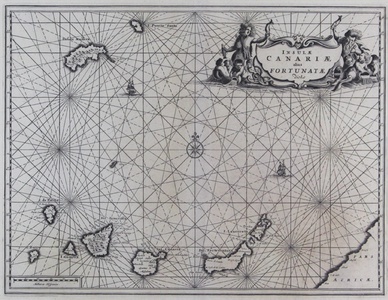| Method | Copper engraved |
| Artist | Dapper, Olfert |
| Published | [Jacob van Meurs, Amsterdam, 1670] |
| Dimensions | 255 x 336 mm |
| Notes |
A decorative map of the Canary Islands, with Madeira and Porto Santo also featured, from the German edition of Dapper's Naukeurige Beschrijvinge der Afrikaensche Gewesten, commonly known as the Description of Africa. The map is adorned with a compass rose, rhumb lines, sailing ships, and a decorative title cartouche, surrounded by merpeople. The Canary Islands play an important part in the history of navigation. In antiquity, the islands were often associated with myths of the Isles of the Blessed, or the location of the famous Garden of the Hesperides from the myth cycles of Hercules. The islands may have been discovered by Hanno the Navigator in the 6th century BC, but are not properly attested until the first century AD, when resettled by King Juba II of Numidia as part of his expansion of the trade in purple dye along the Atlantic coast of modern day Morocco. By the 15th century, the islands had become a vital stopping off point in Atlantic navigation, providing a refuelling point for ships crossing to the New World, or rounding the Cape of Good Hope en route to the Spice Islands in the East Indies. This made the Canaries a popular location for pirates, particularly Ottoman privateers from the North African coast. Kemal Reis and Murat Reis both targeted the islands, in the hope of disrupting Spanish mercantile trade, and the Barbary Pirates made slave raids against the local populace during the early seventeenth century. Colonial powers were also a threat to Spanish dominance, with the most significant attacks coming from the Dutch in 1599, and from the British in 1797. It was during the latter, off the coast of Santa Cruz de Tenerife, that Admiral Nelson lost his arm. Olfert Dapper's 'Description of Africa' was an ethnographic book which offered a detailed description of the parts of Africa known to Europeans in the mid-seventeenth century. Despite the work being regarded as one of the most important and detailed seventeenth-century publications on Africa, Dapper himself never actually visited the continent. Instead, he relied on the reports of Jesuit missionaries and Dutch explorers. The 'Description of Africa' was first published in 1668 by Jacob van Meurs in Amsterdam, with a second Dutch edition appearing in 1676. In 1670, a German translation of the publication was issued, and in the same year, an English translation, which is generally attributed to John Ogilby. A French edition was published in 1676, although it was not as true to the original as the other translations. Olfert Dapper (1636 - 1689) was a Dutch physician and writer. Despite never travelling outside of the Netherlands, Dapper was a writer of world history and geography. Condition: Vertical centre fold as issued. Time toning to sheet |
| Framing | framed |
| Price | £450.00 |
| Stock ID | 44529 |

